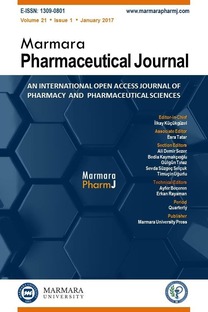Metabolite Production and Antibacterial Activities of Callus Cultures from Rosa damascena Mill. Petals
___
Baydar H. Oil-bearing rose (Rosa damascena Mill.) cultivation and rose oil industry in Turkey. Euro Cosmetics 2006; 14: 13.Kovatcheva-Apostolova EG, Georgiev MI, Ilieva MP, Skibsted LH, Rødtjer A, Andersen ML. Extracts of plant cell cultures of Lavandula vera and Rosa damascena as sources of phenolic antioxidants for use in foods. Eur Food Res Technol 2008; 227: 1243-9.
Sagdiç O, Baydar N, Baydar H. Note: Antioxidant and antibacterial activities of Rosa damascena flower extracts. Food Sci Technol Int 2004; 10: 277-81.
Ulusoy S, Boşgelmez-Tınaz G, Seçilmiş-Canbay H. Tocopherol, carotene, phenolic contents and antibacterial properties of rose essential oil, hydrosol and absolute. Curr Microbiol 2009; 59: 554-8.
Da Porto C, Decorti D, Natolino A. Application of a supercritical CO2 extraction procedure to recover volatile compounds and polyphenols from Rosa damascena. Separ Sci Technol 2015; 50: 1175-80.
Basim E, Basim H. Antibacterial activity of Rosa damascena essential oil. Fitoterapia 2003; 74: 394-6.
Achuthan C, Babu B, Padikkala J. Antioxidant and hepatoprotective effects of Rosa damascena. Pharm Biol 2003; 41: 357-61.
Matkowski A. Plant in vitro culture for the production of antioxidants—a review. Biotechnol Adv 2008; 26: 548-60.
Roberts SC. Production and engineering of terpenoids in plant cell culture. Nature Chem Biol 2007; 3: 387-95.
Namdeo A. Plant cell elicitation for production of secondary metabolites: a review. Pharmacogn Rev 2007; 1: 69-79.
Skrzypczak-Pietraszek E, Słota J, Pietraszek J. The influence of L-phenylalanine, methyl jasmonate and sucrose concentration on the accumulation of phenolic acids in Exacum affine Balf. f. ex Regel shoot culture. Acta Biochim Pol 2014; 61: 47-53.
Arora R. Medicinal plant biotechnology: CABI; 2010.
Pavlov A, Popov S, Kovacheva E, Georgiev M, Ilieva M. Volatile and polar compounds in Rosa damascena Mill 1803 cell suspension. J Biotechnol 2005; 118: 89-97.
Banthorpe DV, Branch SA, Poots I, Fordham WD. Accumulation of 2-phenylethanol by callus derived from leafbud of Rosa damascena. Phytochem 1988; 27: 795-801.
Murashige T, Skoog F. A revised medium for rapid growth and bio assays with tobacco tissue cultures. Physiol Plant 1962; 15: 473-97.
Lampi A-M, Kataja L, Kamal-Eldin A, Vieno P. Antioxidant activities of α-and γ-tocopherols in the oxidation of rapeseed oil triacylglycerols. J Am Oil Chem Soc 1999; 76: 749-55.
Creelman RA, Mullet JE. Biosynthesis and action of jasmonates in plants. Annu Rev Plant Biol 1997; 48: 355-81.
Gala R, Mita G, Caretto S. Improving α-tocopherol production in plant cell cultures. J Plant Physiol 2005; 162: 782-4.
Yamamoto S, Hayashi S, Furusaki S, Shioya S. 5‐Aminolevulinic acid promotes callus growth and paclitaxel production in light‐grown Taxus cuspidata suspension cultures. Eng Life Sci 2015; 15: 116-21.
Zhong Jj, Seki T, Kinoshita Si, Yoshida T. Effect of light irradiation on anthocyanin production by suspended culture of Perilla frutescens. Biotechnol Bioeng 1991; 38: 653-8.
Guarnerio CF, Fraccaroli M, Gonzo I, Pressi G, Dal Toso R, Guzzo F, Levi M. Metabolomic analysis reveals that the accumulation of specific secondary metabolites in Echinacea angustifolia cells cultured in vitro can be controlled by light. Plant Cell Rep 2012; 31: 361-7.
Sooriamuthu S, Varghese RJ, Bayyapureddy A, John SST, Narayanan R. Light-induced production of antidepressant compounds in etiolated shoot cultures of Hypericum hookerianum Wight & Arn.(Hypericaceae). Plant Cell, Tissue Organ Cult (PCTOC) 2013; 115: 169-78.
Shinde AN, Malpathak N, Fulzele DP. Determination of isoflavone content and antioxidant activity in Psoralea corylifolia L. callus cultures. Food Chem 2010; 118: 128-32.
Dudareva N, Pichersky E, Gershenzon J. Biochemistry of plant volatiles. Plant Physiol 2004; 135: 1893-1902.
Köllner TG, Lenk C, Zhao N, Seidl-Adams I, Gershenzon J, Chen F, Degenhardt J. Herbivore-induced SABATH methyltransferases of maize that methylate anthranilic acid using S-adenosyl-L-methionine. Plant Physiol 2010; 153: 1795-1807.
Sreekumar S, Seeni S, Pushpangadan P. Micropropagation of Hemidesmus indicus for cultivation and production of 2-hydroxy 4-methoxy benzaldehyde. Plant Cell, Tissue Organ Cult 2000; 62: 211-8.
- ISSN: 1309-0801
- Yayın Aralığı: Yılda 6 Sayı
- Başlangıç: 1985
- Yayıncı: Marmara Üniversitesi
Mean Centering Method for determination of Empagliflozin and Metformin
Bassam M. AYOUB, Rola M EMAM, Mahmoud M. YOUSSEF, Muhammad N. EL-KATTAN, Marwa A. SAYED, Ahmed M. KOWİDER, Adly H. SEHA, Engy A. RABEA, Rana M. YAKOUT, Rolly H. FARİED
YAVUZ SELİM ÇAKMAK, GÖKHAN ZENGİN, BÜLENT ESKİN, Kevser YILDIRIM, Müge TOPAL, Gözde HATUN AYDIN, Emre ÜNLÜ, Merve BAYDEMİR, Kübra ERTEN
Kailas K MALI, Shashikant C DHAWALE, Remeth J DIAS
Manısh Sudesh BHATIA, Jıvan N. RAUT, Anuja C. BARVE, Prachı S. PATIL, Swapnıl D. JADHAV
NESRİN HAŞİMİ, ABDULSELAM ERTAŞ, Elif VARHAL ORAL, MEHMET HÜSEYİN ALKAN, MEHMET BOĞA, MUSTAFA ABDULLAH YILMAZ, İSMAİL YENER, IŞIL GAZİOĞLU, Cumali Özaslan, Mehmet AKDENİZ, UFUK KOLAK
Elektroeğrilmiş Nanoliflerin İlaç Taşıyıcı Sistem Olarak ve Doku Mühendisliğinde Kullanımı
